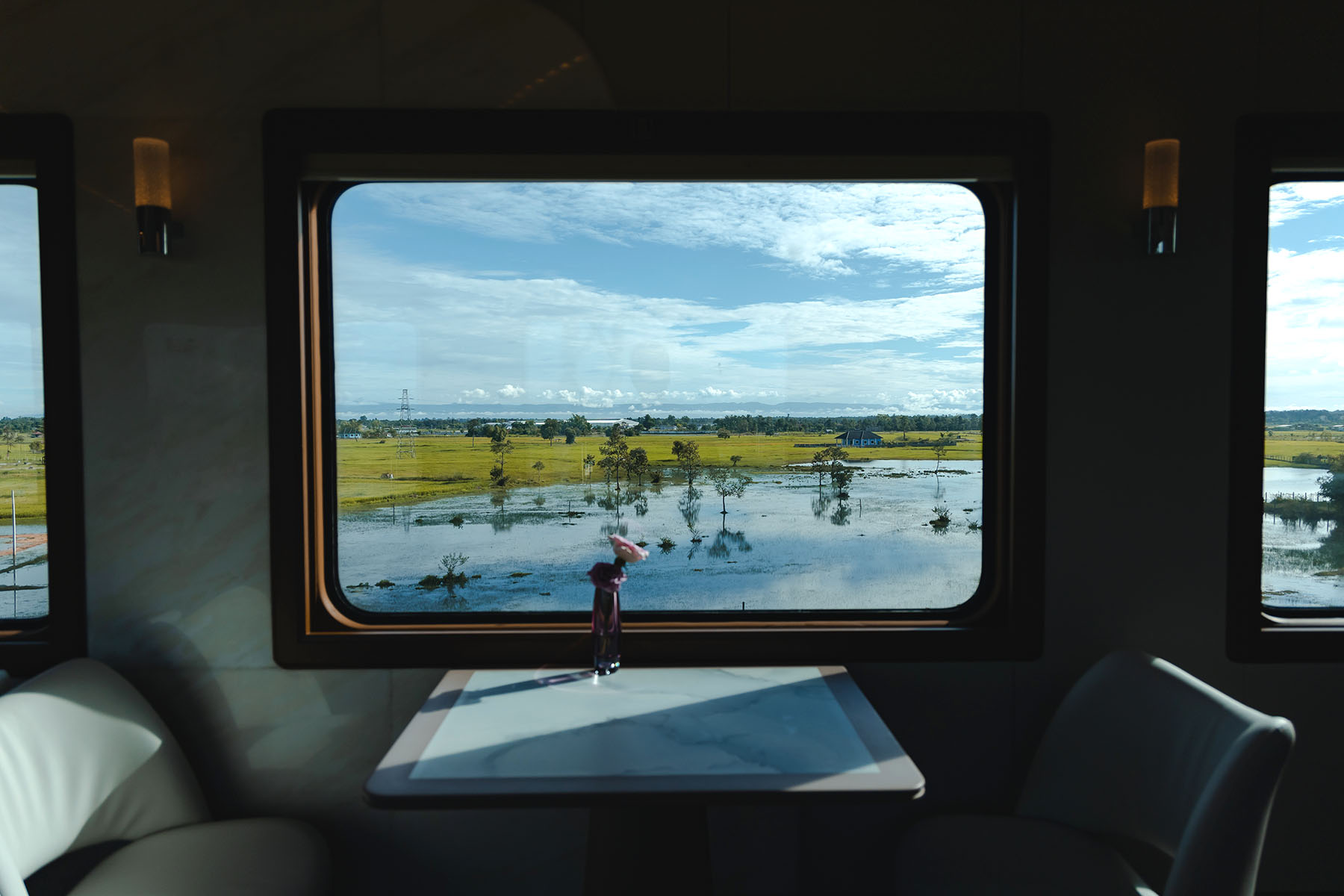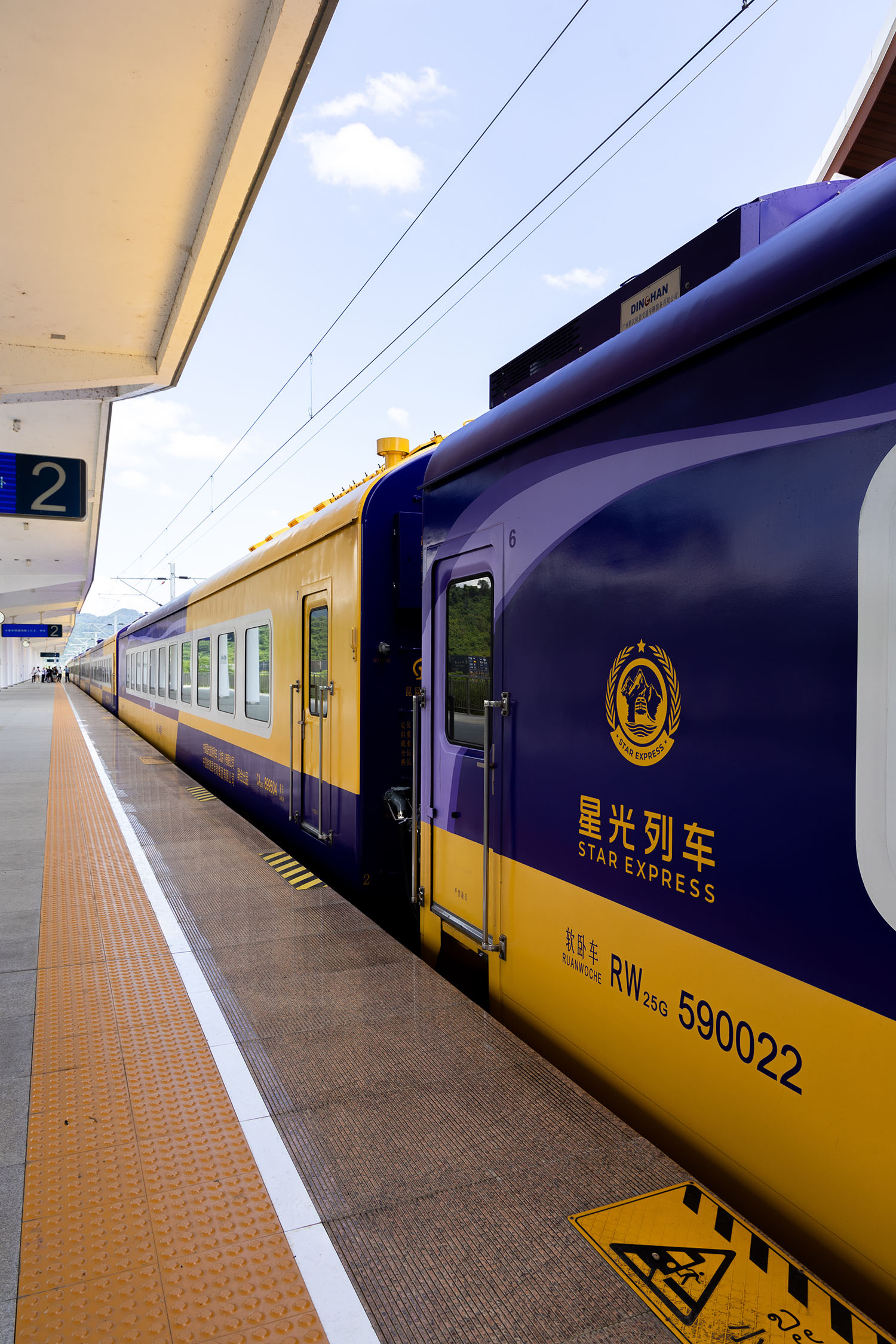New transport option allows travelers the opportunity to view the sights of Laos from the comfort of a high-class train, Yang Feiyue reports.

Lao guide Geng Vang took a special group of Chinese guests to savor the blend of natural beauty, history and culture that his hometown Luang Prabang offers late last month.
Fluent in Mandarin, the man in his 30s ensured the group was well-informed of the cultural relics on display at the Royal Palace Museum, which was built in 1904 and originally served as the residence of the founding king of the Kingdom of Laos, Sisavang Vong, and his family. He also took them to enjoy a stunning bird's-eye view of the whole city on top of Mount Phousi.
They wrapped up the trip at a big night market, where the Chinese travelers could buy local handicrafts, textiles and street food.
"It was a half-day trip, so I tried to cram in as much detailed information as possible about those scenic spots," Vang says.
READ MORE: Faster by rail, the line linking China and Laos
His guests were part of about 60 Chinese travelers, who were on the maiden voyage of the newly developed cross-border tourism train StarExpress that connects Kunming, the capital of Southwest China's Yunnan province, and Vientiane, the capital of Laos.
It was developed by CTG Asset, a subsidiary of the Hong Kong-headquartered China Tourism Group, to implement the Belt and Road Initiative and promote cultural and tourism exchanges between the two countries.
Departing from Kunming, the train crosses the Tropic of Cancer, passes through the UNESCO World Heritage city of Luang Prabang, and arrives in Vientiane.
During the inaugural package of three nights and four days that concluded on Sept 27, passengers enjoyed beautiful landscapes, diverse cultures and ethnic customs.
In addition to strolling through the Buddhist land of Luang Prabang, they explored French colonial architecture, Buddhist temples and a relaxed riverside vibe traveling in Vientiane.
"I've been to many countries, but it is the first time I visited Laos, thanks to the train," says Liu Yaling, a guest on the train tour.

Liu works for Beijing Yumei International Travel Agency and heard a lot about tourism trains at home and abroad but had never experienced one.
"The rich amenities and services on the train are alluring and it also offers cross-border experiences," Liu says about her decision to get on board.
The train was designed and renovated by professional teams from home and abroad, considering environmental protection and safety.
It features leading domestic high-speed rail soundproofing technology and an integrated intelligent information system, complemented by a user-friendly smart operating system.
Entertainment facilities such as on-demand movies and interactive games are available to enhance travelers' experiences.
Liu says the butler service, catering and cultural experiences on the train, including tea rituals and ethnic dances, made her trip sweet and relaxing. "I feel the crew really put their heart into it," she says.
Most of Liu's clients are 45 to 65 years old, an age group she considers having the time and money to travel and showing interest in customized trips, including those to the polar regions. "Many of them made inquiries about the train", she adds.
Plans have been made to introduce a six-night, seven-day tour package after the National Day holiday. Liu believes the market potential will be great. "They will surely appeal to those who seek novel travel experiences," she says.
Tourists on the China-Laos Railway initially used it as a means of transportation and would buy a ticket and travel to Laos for sightseeing, says Jia Lei, an official with the StarExpress train operations.
"What sets this cross-border tourism train apart is that we are treating it as a tourism product and an upgrade of the original China-Laos Railway tourism experience," Jia says, adding that the train will be a vehicle to promote more tourism train products across the country.
The initial plan involves two product lines, he says. One line will focus on high-quality trains, similar to that of the Star-Express and the other line is said to be more akin to sightseeing tourism trains in Japan, Europe and Canada, according to Jia.

He notes that China boasts a high-density railway network. In addition to the high-speed rail, the previous conventional system is suited for tourism as it covers areas where high-speed rail is not as prevalent.
Areas in China such as the Northeast, Northwest and Southwest have a strong railway infrastructure and abound in tourism resources along the way, which makes them ideal for tourism trains, he says.
The launch of StarExpress is not only a significant breakthrough for China's tourism train industry but also an important milestone in CTG Asset's efforts to deepen tourism cooperation between China and Laos and promote the development of tourism along the China-Laos Railway, according to the company.
"The opening of the China-Laos Railway in 2021 is a tangible achievement of the BRI and a prime example of China sharing development opportunities with the world in a more open manner," says Lu Lu, chairman of CTG Asset.
The StarExpress train operating on the China-Laos Railway traverses mountains and rivers and will strengthen the friendship between China and Laos, supporting the BRI, Lu adds.
Chinese travelers have warmed to Laos since the China-Laos Railway went into operation and the recent visa-free policy has fueled their enthusiasm, says Guan Jian, an official with the Guangdong-based travel agency EC Walk.
ALSO READ: Hit travel reality show ventures abroad to Laos
The Lao government has introduced a visa-free policy for Chinese travelers accompanied by certified travel agents since July 1.
The announcement of the policy on June 26, which will end in June 2025, saw searches the next day for Laos tours on major travel agency Trip.com Group surge by 87 percent over the previous day, according to the agency.
Orders from mainland travelers to Laos have more than doubled year-on-year, with summer travel orders increasing by over 140 percent over the same period last year, data from Trip.com reveals.
Vang is happy about the operation of the tourism train and believes it will benefit his job as a tour guide.
"Chinese tourists have greatly increased since the opening of the China-Laos Railway and I receive two to three groups, each with 20 Chinese travelers, daily," Vang says.
He had trouble finding a job as an English teacher after graduation and decided to pick up Mandarin after seeing the potential increase in tourists from China.
"More are expected to come now that the tourism train is up and running," Vang says.
Contact the writer at yangfeiyue@chinadaily.com.cn



